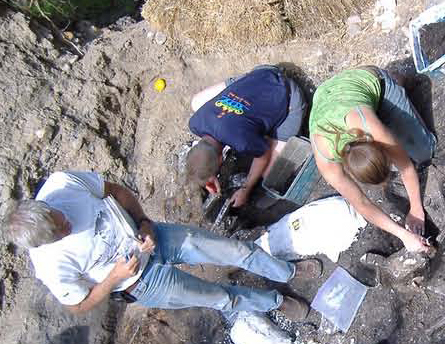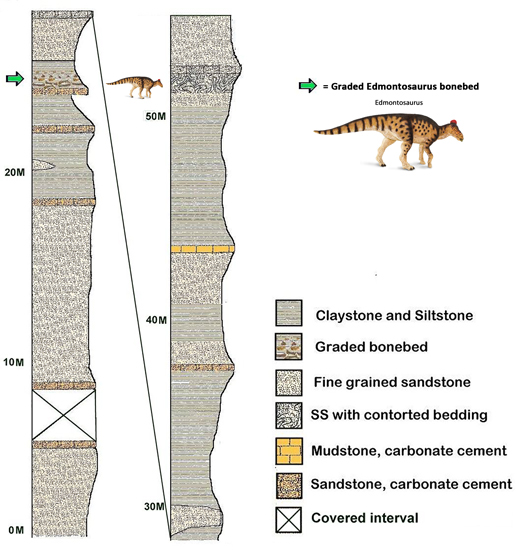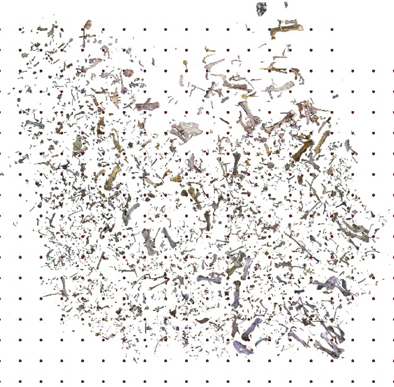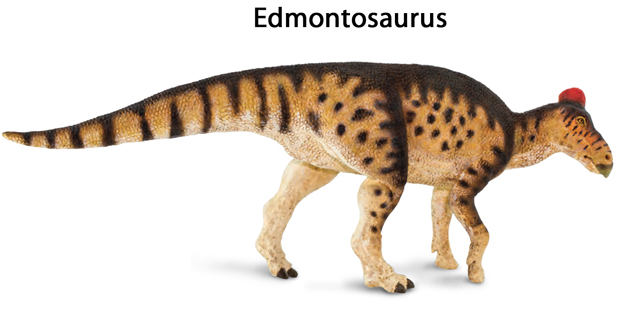13,000 Edmontosaurus an Astonishing Dinosaur Bonebed
Massive Edmontosaurus Bonebed Provides Data on Dinosaur Decomposition
A team of scientists have produced a study mapping an astonishing dinosaur bonebed that has so far yielded a staggering total of 13,000 individual fossil elements. In truth, the bonebed contains many more fossils, but individual dinosaur teeth, ossified tendons and other fragmentary elements under five centimetres in length have not been counted.
Edmontosaurus annectens
The site is located in eastern Wyoming and consists almost entirely of the preserved remains of a single type of dinosaur, a hadrosaur (Edmontosaurus annectens). The bonebed study has not only provided a great deal of information about this duck-billed dinosaur but shed light on how death assemblages consisting of a large number of corpses are formed and how various bones of differing sizes might be transported before final deposition.
Dinosaur Bonebeds such as the Danek Edmontosaurus regalis Bonebed in Edmonton Have Yielded Thousands of Fossil Bones

Picture credit: Victoria Arbour
The Hanson Ranch Bonebed (Lance Formation)
Writing in the on-line, open access journal PLOS One, the scientists which include Keith Synder of the Biology Dept. of the Southern Adventist University, Tennessee, document the taphonomy and depositional history of an extensive E. annectens bonebed known as Hanson Ranch, in the Lance Formation of eastern Wyoming. The bonebed includes five main quarries and three exploratory quarries. Approximately 13,000 elements including around 8,400 identifiable bones, have been recovered in 506 square metres of excavated area in twenty years (1996-2016).
Virtually all the fossils are located within a fine-grained (claystone to siltstone) bed that has a maximum depth of two metres.
Mapping the Stratigraphy of the Main Bonebeds at the Hanson Research Station (Wyoming)

Picture credit: Synder et al (PLOS One) with additional annotation by Everything Dinosaur
Edmontosaurus annectens Fossils in an Excellent State of Preservation
Almost all the fossils recovered from the site exhibit exquisite preservation with little or no abrasion, breakages or signs of weathering prior to deposition. All the material is disarticulated and scattered although over a relatively confined area. This evidence in conjunction with analysis of the sediments associated with the fossils indicates that the bones were moved and buried after a period of initial decay and decomposition of the Edmontosaurus carcasses.
Mapping the Distribution of Fossil Bones in a Bonebed
Picture credit: Synder et al (PLOS One)
Gaining a Better Understanding of Edmontosaurus Biostratigraphy
The thousands of fossil bones represent mainly adult or sub-adult specimens. Due to the huge number of fossils associated with the Hanson Research site, the scientists have been able to gain a deeper understanding of Edmontosaurus biostratigraphy including how elements from the skeleton can be transported over distances prior to deposition. The most abundant fossil bones are ischia, pubes, scapulae, ribs and limb bones. In contrast, vertebrae, ilia and chevrons are rare.
Explaining the Composition of the Bonebed
When it comes to cranial material lower jaw bones (dentaries), nasals, quadrates and jugals are prevalent whilst premaxillae (upper jaw bones), predentaries and bones associated with the braincase are seldom found. The researchers suggest that following decay and break-up of the carcase, water action sorted and removed the articulated sections such as the backbone and the smaller bones such as the digits and toes, before, or at the same time, the remaining material was swept up in a subaqueous debris flow that created the final deposit.
The scientists suggest that similar processes may have been at work that created the other hadrosaurid-dominated Upper Cretaceous bonebeds associated with such geological formations as Hell Creek, Two Medicine, Horseshoe Canyon, Prince Creek as well as the Lance Formations of western North America. It is noted that there is a remarkably similar skeletal composition among the fossil bonebeds studied. It is also noted that there is a significant correlation between the hadrosaurid bonebeds and fluvial assemblages representing thanatocoenosis* events seen with modern-day vertebrate death assemblages.
Thanatocoenosis* Explained
Thanatocoenosis refers to a site where a collection of fossils representing a variety of organisms are found together. Such sites are often referred to as death assemblages. The organisms represented at the location may not have been associated in life, but their remains have been transported and deposited together thus forming a fossil bed composed of an extensive amount of fossilised material.
Not All of the Dinosaur Fossils are Edmontosaurus
The bonebed can be described as monodominant as the vast majority of the fossil material found can be assigned to just one species Edmontosaurus annectens. Non-dinosaurian terrestrial taxa identified include mammals and squamates along with the remains of many aquatic creatures such as crocodiles, turtles, gar and other fishes and numerous molluscs. Some other types of plant-eating dinosaur are represented notably, ceratopsids, pachycephalosaurs, nodosaurs and members of the family Thescelosauridae. Numerous shed theropod teeth are also associated with this location.
Everything Dinosaur will post up a separate article detailing one rather special theropod fossil associated with a quarry close to the Hanson Research station in the near future.
A Life Reconstruction of the Hadrosaurid Edmontosaurus
The picture (above) highlights the 2020 Wild Safari Prehistoric World Edmontosaurus dinosaur model.
To view this range: Wild Safari Prehistoric World Models.
The scientific paper: “Over 13,000 elements from a single bonebed help elucidate disarticulation and transport of an Edmontosaurus thanatocoenosis” by Keith Snyder, Matthew McLain, Jared Wood and Arthur Chadwick published in PLOS One.
Visit the Everything Dinosaur website: Everything Dinosaur.



